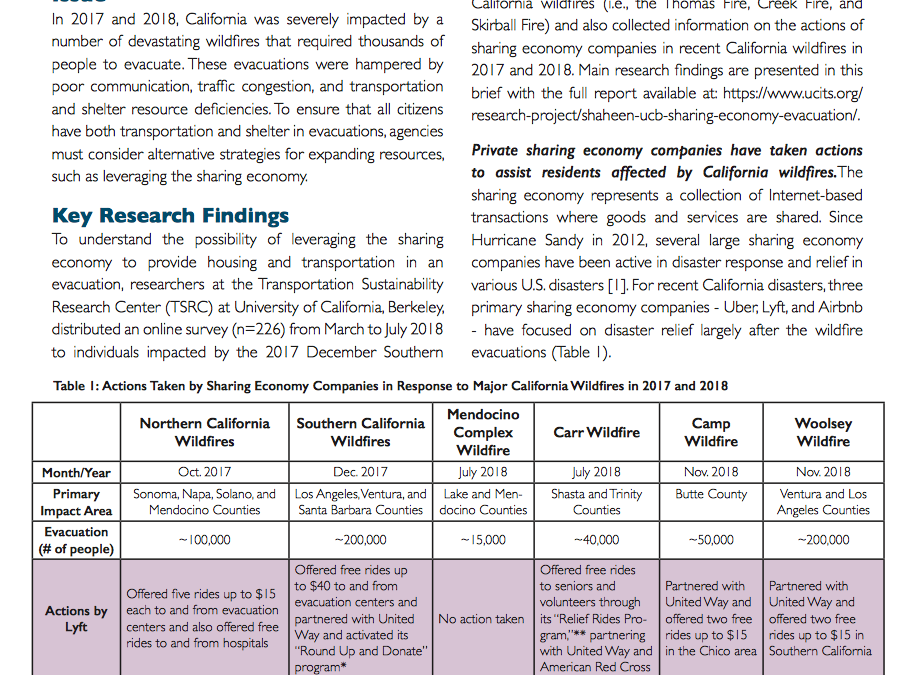by Innovative Mobility Research | Feb 28, 2020 |
Authors: Susan Shaheen, PhD, Adam Cohen, Nelson Chan, and Apaar Bansal Date: January 2020 Abstract: Shared mobility—the shared use of a vehicle, bicycle, or other mode—is an innovative transportation strategy that enables users to gain short-term access to transportation modes on an “as-needed” basis. It includes various forms of carsharing, bikesharing, scooter sharing, ridesharing (carpooling and vanpooling), transportation network companies (TNCs), and microtransit. Included in this ecosystem are smartphone “apps” that aggregate and optimize these mobility options, as well as “courier network services” that provide last mile package and food delivery. This chapter describes different models that have emerged in shared mobility and reviews research that has quantified the environmental, social, and transportation-related impacts of these services....

by Innovative Mobility Research | Jun 26, 2019 |
Authors: Stephen Wong and Susan Shaheen, PhD Date: June 2019 Abstract: In 2017 and 2018, California was severely impacted by a number of devastating wildfires that required thousands of people to evacuate. These evacuations were hampered by poor communication, traffic congestion, and transportation and shelter resource deficiencies. To ensure that all citizens have both transportation and shelter in evacuations, agencies must consider alternative strategies for expanding resources, such as leveraging the sharing economy. This policy brief presents key research findings from the report “Current State of the Sharing Economy and Evacuations: Lessons from California” as well as policy recommendations for evacuation planning at the state and local level. View...
by Innovative Mobility Research | Jan 8, 2019 |
Authors: Jeffery Greenblatt, Susan Shaheen, PhD Date: July 2015 Abstract: We review the history, current developments, projected future trends and environmental impacts of automated vehicles (AVs) and on-demand mobility, and explore potential synergies. Many automobile manufacturers and Google plan to release AVs between 2017 and 2020, with potential benefits including increased safety, more efficient road use, increased driver productivity and energy savings. Estimates of AV energy use and greenhouse gas (GHG) emissions range from an ~80 % or greater decrease to a threefold increase; however, we argue that net decreases are likely. On-demand mobility services exist in many cities around the world, with advances in mobile technology increasing their popularity. On-demand mobility can provide numerous transportation, land use, and environmental and social benefits, and users tend to decrease both vehicle ownership and annual vehicle distances traveled. Combining on-demand mobility and AVs may amplify adoption of both, and further lower energy use and GHG emissions through the use of small, efficient shared AVs. View...
by Innovative Mobility Research | Jan 8, 2019 |
Authors: Lisa Rayle, Danielle Dai, Nelson Chan, Robert Cervero, Susan Shaheen, PhD Date: January 2016 Abstract: In this study, we present exploratory evidence of how “ridesourcing” services (app-based, on-demand ride services like Uber and Lyft) are used in San Francisco. We explore who uses ridesourcing and for what reasons, how the ridesourcing market compares to that of traditional taxis, and how ridesourcing impacts the use of public transit and overall vehicle travel. In spring 2014, 380 completed intercept surveys were collected from three ridesourcing “hot spots” in San Francisco. We compare survey results with matched-pair taxi trip data and results of a previous taxi user survey. We also compare travel times for ridesourcing and taxis with those for public transit. The findings indicate that, despite many similarities, taxis and ridesourcing differ in user characteristics, wait times, and trips served. While ridesourcing replaces taxi trips, at least half of ridesourcing trips replaced modes other than taxi, including public transit and driving. Impacts on overall vehicle travel are unclear. We conclude with suggestions for future research. View...

by Innovative Mobility Research | Oct 27, 2016 |
In recent years, technological and social forces have pushed smartphone applications (apps) from the fringe to the mainstream. Understanding the role of transportation apps in urban mobility is important for policy development and transportation planners. This study evaluates the role and impact of multimodal aggregators from a variety of perspectives, including a literature review; a review of the most innovative, disruptive, and highest-rated transportation apps; interviews with experts in the industry, and a user survey of former multimodal aggregator RideScout users. Between February and April 2016, researchers conducted interviews with experts to gain a stronger understanding about challenges and benefits of data sharing between private companies and public agencies. Key findings from the expert interviews include the critical need to protect user privacy; the potential to use data sharing to address integrated corridor and congestion management as well as various pricing strategies during peak hours; along with the potential benefits for improving coordination between the public and private sectors. In March 2016, researchers surveyed 130 people who had downloaded the RideScout app to evaluate attitudes and perceptions toward mobile apps, travel behavior, and modal shift. The goal was to enhance understanding of how the multimodal apps were impacting the transportation behavior. The survey did found that respondents used multimodal apps in ways that yielded travel that was less energy intensive and more supportive of public transit. Looking to the future, smartphone applications and more specifically multimodal aggregators, may offer the potential for transportation planners and policymakers to enhance their understanding of multimodal travel behavior, share data, enhance collaboration, and identify opportunities for public-private partnerships....


